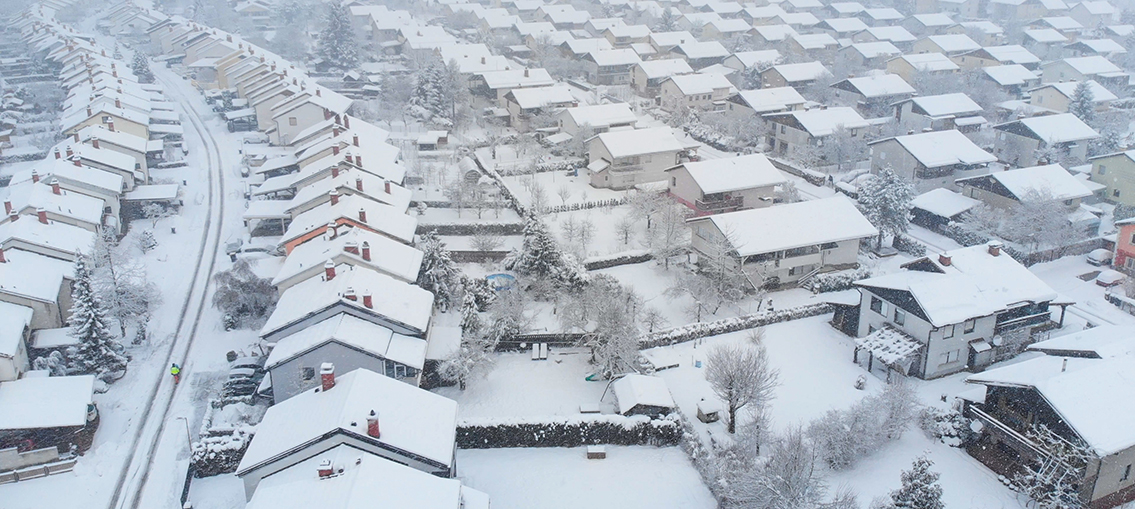In the dead of winter, cold snaps that bring freezing temperatures can linger for weeks and even months in some places. Depending on where you live, you may not experience such intense bouts of weather, but it brings an extra set of risks and dangers for homeowners. For those who experience this severe cold weather, it’s best to prepare yourself and your home to ensure you stay safe and warm even on the coldest nights.
Here are some tips you make sure your home is ready for the next cold front that rolls in:
1) Make Sure Your Home is Insulated
Drafts coming from your windows and doors let in cold air, making your furnace work harder to keep your home warm. If you notice strong drafts coming in, you can improve your insulation by weather-stripping your windows and doors or applying caulk to plug the drafts. If you live in an older home, you may even consider replacing your old, drafty ones with storm windows and doors. You can install window insulation film or sheet kits to help contain drafty windows for a quick short-term fix. Improving your home’s insulation will keep your energy costs down and reduce the risk of overworking your furnace.
2) Prepare Your Furnace
Before winter fully sets in, it’s a good idea to schedule a routine check-up with a local HVAC professional to inspect your furnace or HVAC. They will assess the condition of your unit and recommend any maintenance or repairs that may be required before the heavy use seasons take hold. If you already had this service completed earlier in the year, you may still want to take care of some additional upkeep, such as cleaning your vents and replacing your air filters. Getting your furnace in good working order will prevent surprises and help you stay ahead of any issues by resolving them sooner rather than later.
3) Inspect Your Fireplace and Chimney
Nothing beats a cozy fire on a cold night! But before you light your first log, you’ll want to have your fireplace and chimney inspected by a professional chimney sweep to make sure that it’s safe to have a fire. Reaching out to organizations like the Chimney Safety Institute of America (CSIA) is a good start for finding a reputable, licensed chimney specialist in your area. In addition to inspecting the various components of the system, they will also remove excess debris and buildup that could pose a fire hazard. After the inspection and any required maintenance, you can light fires in your home with greater peace of mind. Just remember to keep the flue closed when your fireplace is not in use, so you don’t lose any warmth.
4) Clean Out Your Gutters
Having clean gutters is crucial to transport water away from your home year-round properly but becomes especially important during the winter months. When snow and ice melt from your roof, you want to ensure it can easily flow down and out through your gutter system, unhindered by buildup and debris in your gutters. You want to avoid ice dams forming when meltwater collects in the gutters and freezes inside them, causing water to seep into the home. Before a heavy winter storm hits, be sure to check on your gutters and clean them out if you find any debris. Ensuring your attic has proper ventilation can also naturally help your home prevent ice dams.
5) Set Your Thermostat
As already mentioned, you want to be mindful about overworking your furnace during these stretches with below-freezing temperatures. The last thing you want on a freezing night is having to track someone down to service your furnace that isn’t working. In addition to taking measures to insulate your home, you may consider gradually lowering your thermostat by a degree or two to acclimate yourself to cooler temperatures in your home so that you can lessen the load on your furnace. However, you will want to keep your home at a minimum of 65 degrees so that your pipes do not freeze and potentially burst. Lastly, if you have overhead fans in your home, be sure to set them to rotate clockwise, which will push the warm air down from the ceiling and make your home feel warmer.
6) Prevent Your Pipes from Freezing
With severely cold weather, there’s always a chance that your pipes could freeze and potentially burst, which will result in a messy and expensive cleanup. Pipes located in attics, basements, exterior walls, or any other area that gets especially cold are most suspectable to this issue. To prevent pipes from freezing, you can take steps such as insulating them, letting water drip from the connected faucets, turning up your thermostat, and opening cabinet doors to let warm air in around them. If they ever freeze and burst, you will want to immediately shut off your home’s water connection. For that reason, be sure to familiarize yourself with the location of your main water shut-off and know how to turn it off.
7) Stock Up on Supplies
If a cold snap or snowstorm is heading your way, be sure to track down some essential supplies to have on hand in case of an emergency. Non-perishable food and water are always a good idea to have well-stocked. Take care of any necessary errands, such as refilling prescriptions before the storm hits, and make sure to top off your car with a full tank of gas on the way back.
Wrapping Up
Freezing temperatures come with additional obstacles and risks for homeowners to consider and prepare for accordingly. However, by taking suitable precautions, you will be able to ride out the winter months from the comfort and safety of your home!



